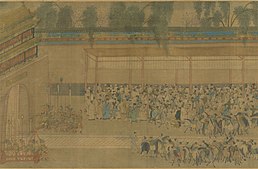
Back اختبارات إمبراطورية Arabic Exàmens imperials xinesos Catalan تاقیکردنەوەی شاھانە CKB Úřednické zkoušky v Číně Czech Det kejserlige embedsmandseksamenssystem Danish Chinesische Beamtenprüfung German Σύστημα εξετάσεων στην Αυτοκρατορική Κίνα Greek Ekzamensistemo en la ĉina imperio Esperanto Sistema de examen imperial chino Spanish Examens impériaux French
科舉
| Imperial examination | |||||||||||||||||||||||||||
|---|---|---|---|---|---|---|---|---|---|---|---|---|---|---|---|---|---|---|---|---|---|---|---|---|---|---|---|
 "Imperial examinations" in Traditional (top) and Simplified (bottom) Chinese characters | |||||||||||||||||||||||||||
| Chinese name | |||||||||||||||||||||||||||
| Traditional Chinese | 科舉 | ||||||||||||||||||||||||||
| Simplified Chinese | 科举 | ||||||||||||||||||||||||||
| Hanyu Pinyin | kējǔ | ||||||||||||||||||||||||||
| |||||||||||||||||||||||||||
| Vietnamese name | |||||||||||||||||||||||||||
| Vietnamese alphabet | khoa bảng khoa cử | ||||||||||||||||||||||||||
| Chữ Hán | 科榜 科舉 | ||||||||||||||||||||||||||
| Korean name | |||||||||||||||||||||||||||
| Hangul | 과거 | ||||||||||||||||||||||||||
| Hanja | 科擧 | ||||||||||||||||||||||||||
| |||||||||||||||||||||||||||
| Japanese name | |||||||||||||||||||||||||||
| Hiragana | かきょ | ||||||||||||||||||||||||||
| Kyūjitai | 科擧 | ||||||||||||||||||||||||||
| Shinjitai | 科挙 | ||||||||||||||||||||||||||
| |||||||||||||||||||||||||||
| Manchu name | |||||||||||||||||||||||||||
| Manchu script | ᡤᡳᡡ ᡰ᠊ᡳᠨ ᠰᡳᠮᠨᡝᡵᡝ | ||||||||||||||||||||||||||
| Möllendorff | giū žin simnere | ||||||||||||||||||||||||||
The imperial examination (Chinese: 科舉; pinyin: kējǔ; lit. "subject recommendation") was a civil service examination system in Imperial China administered for the purpose of selecting candidates for the state bureaucracy. The concept of choosing bureaucrats by merit rather than by birth started early in Chinese history, but using written examinations as a tool of selection started in earnest during the Sui dynasty[1][2] (581–618) then into the Tang dynasty of 618–907. The system became dominant during the Song dynasty (960–1279) and lasted for almost a millennium until its abolition during the late Qing dynasty reforms in 1905. Aspects of the imperial examination still exist for entry into the civil service of contemporary China, in both the People's Republic of China and Taiwan.
The exams served to ensure a common knowledge of writing, Chinese classics, and literary style among state officials. This common culture helped to unify the empire, and the ideal of achievement by merit gave legitimacy to imperial rule. The examination system played a significant role in tempering the power of hereditary aristocracy and military authority, and in the rise of a gentry class of scholar-bureaucrats.
Starting with the Song dynasty, the imperial examination system became a more formal system and developed into a roughly three-tiered ladder from local to provincial to court exams. During the Ming dynasty (1368–1644), authorities narrowed the content down to mostly texts on Neo-Confucian orthodoxy; the highest degree, the jinshi (Chinese: 進士), became essential for the highest offices. On the other hand, holders of the basic degree, the shengyuan (生員), became vastly oversupplied, resulting in holders who could not hope for office. During the 19th century, the wealthy could opt into the system by educating their sons or by purchasing an office. In the late 19th century, some critics within Qing China blamed the examination system for stifling scientific and technical knowledge, and urged for some reforms. At the time, China had about one civil licentiate per 1000 people. Due to the stringent requirements, there was only a 1% passing rate among the two or three million annual applicants who took the exams.[3]
The Chinese examination system has had a profound influence in the development of modern civil service administrative functions in other countries.[4] These include analogous structures that have existed in Japan,[5] Korea, the Ryukyu Kingdom, and Vietnam. In addition to Asia, reports by European missionaries and diplomats introduced the Chinese examination system to the Western world and encouraged France, Germany as well as the British East India Company (EIC) to use similar methods to select prospective employees. Seeing its initial success within the EIC, the British government adopted a similar testing system for screening civil servants across the board throughout the United Kingdom in 1855. The United States would also establish such programs for certain government jobs after 1883.
- ^ "Who Invented Exams? Standardized Testing Creator". 5 March 2022. Retrieved 11 March 2022.
- ^ Chu 2020, p. 1.
- ^ Elman 2009, pp. 405–406.
- ^ Creel, Herrlee G. (March 1974). "Shen Pu-Hai: A Secular Philosopher of Administration". Journal of Chinese Philosophy. 1 (2): 119–136. doi:10.1111/j.1540-6253.1974.tb00644.x.
- ^
Wang, Rui (2013). The Chinese Imperial Examination System: An Annotated Bibliography. Lanham, Maryland: Rowman & Littlefield. p. 18. ISBN 9780810887022. Retrieved 5 January 2022.
Japan was the first country to adopt the Chinese [examination] system, and the Japanese system lasted about 200 years, from the seventh to the eighth centuries.
© MMXXIII Rich X Search. We shall prevail. All rights reserved. Rich X Search
